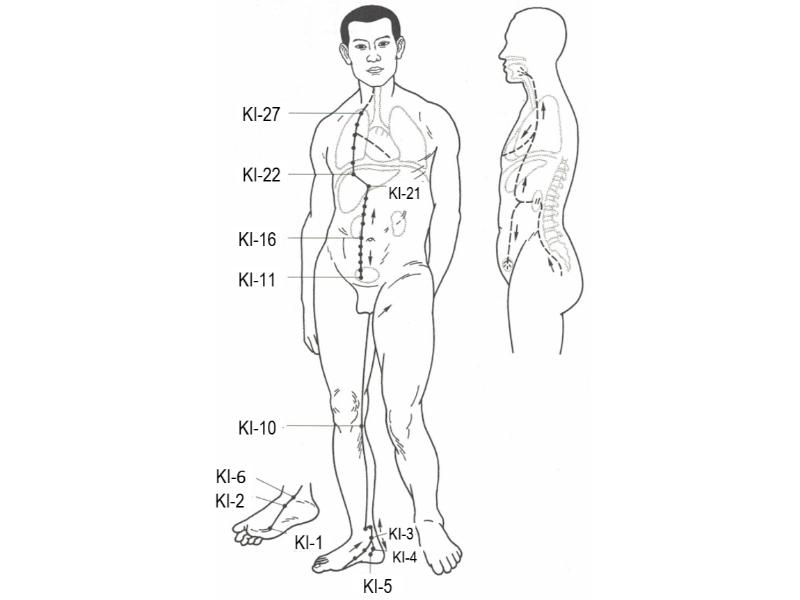Search in dictionary
Foot lesser yīn (shào yīn) kidney channel
足少阴肾经 〔足少陰腎經〕 zú shào yīn shèn jīng
Abbreviation: KI. One of the twelve channels.
Connections
BL → KI → PC; homes to the kidney; nets the bladder.
Kidney Channel Pathway
Overview
Small toe → sole of the foot → around inner ankle body → inside of the leg → base of spine → homes to kidney (and nets bladder) → lung → root of the tongue.- Branch: lung → heart and disperses in chest → PC channel.
Description
The foot lesser yīn (shào yīn) kidney channel starts on the underside of the little toe, runs obliquely over the sole of the foot to KI-1 (yǒng quán, Gushing Spring) and onward to emerge out of the arch of the foot under the tuberosity of the navicular bone at KI-2 (rán gǔ, Blazing Valley). It then proceeds posterior to the medial malleolus and continues into the heel. From here, it travels up the rear medial aspect of the lower leg to intersect with the foot greater yīn (tài yīn) (tai yīn) spleen channel at SP-6 (sān yīn jiāo, Three Yīn Intersection). Traveling up through the gastrocnemius muscle, it ascends across the medial aspect of the popliteal fossa and the posteromedial aspect of the thigh to the base of the spine, where it intersects with the governing vessel at GV-1 (cháng qiáng, Long Strong). It continues up the interior of the spinal column to home to the kidney, after which it turns downwards to net the bladder and intersect with the controlling (rèn) vessel at CV-4 (guān yuán, Pass Head) and CV-3 (zhōng jí, Central Pole).
 |
| Foot lesser yīn (shào yīn) kidney channel |
|---|
From the kidney, the main pathway goes directly to the liver, crosses the diaphragm, enters the lung, and follows the throat up to either side of the root of the tongue.
A branch from the lung, links through to the heart, and disperses in the chest and meets the reverting yīn (jué yīn) pericardium channel.
Kidney Channel Acupoints
Indications of KI Channel Acupoints
The 27 points on the foot lesser yīn (shào yīn) kidney channel treat diseases of the kidney, anterior yīn (the genitals), gynecological disorders, disorders of the lung and throat, and other local problems in areas traversed by the channel.
- Kidney and bladder: Urinary stoppage, enuresis, inhibited urination.
- Reproduction and genitals: Menstrual irregularities, painful menstruation, flooding and spotting, and vaginal discharge; seminal emission and impotence, mounting qì (hernia).
- Head and ears: Dizziness, tinnitus, deafness.
- Lung and throat: Cough, coughing of blood, panting, dry mouth, painful swollen throat.
- Digestive tract: Diarrhea, constipation, abdominal pain, vomiting.
- External pathway: Lumbar pain, popliteal pain, lower leg pain.
Major KI Acupoints
KI-1 (涌泉 yǒng quán, Gushing Spring): Located on the inferior aspect of the foot, on a line drawn along the length of the foot roughly midway between the big and little toes, slightly posterior to the ball of the foot (about one third of the distance from the base of the toes to the posterior aspect of the heel).
- Indications: Headache; clouded head; insomnia; dizzy vision; painful swollen throat; loss of voice; constipation; inhibited urination; child fright wind; mania and withdrawal; clouding reversal.
- Stimulus: Needling: 0.3–0.5 cùn perpendicular insertion. Moxa: 3 cones; pole 5–15 min.
- Categories: Well (jǐng) (wood) point; one of the nine needles for returning yáng.
KI-2 (然谷 rán gǔ, Blazing Valley): Located on the medial aspect of the foot, in the depression inferior to the tuberosity of the navicular bone.
- Indications: Menstrual irregularities; seminal emission; dispersion-thirst; diarrhea: coughing of blood; painful swollen throat; inhibited urination; umbilical wind; clenched jaw.
- Stimulus: Needling: 0.3 cùn perpendicular insertion. Moxa: 3 cones; pole 5–10 min.
- Categories: Spring (yíng) (fire) point.
- Indications: Menstrual irregularities; seminal emission; impotence; frequent urination; constipation; dispersion-thirst; coughing of blood; panting; painful swollen throat; toothache; insomnia; lumbar pain; deafness; tinnitus.
- Stimulus: Needling: 0.3 cùn perpendicular insertion. Moxa: 3 cones; pole 5–10 min.
- Categories: Stream (shù) (earth) and source point (yuán xué); one of the nine needles for returning yáng.
| Indications for KI Points |
|---|
|
KI-6 (照海 zhào hǎi, Shining Sea): Located on the medial aspect of the foot, about 1 cùn inferior to the lower border of the medial malleolus, inferior to the tibialis posterior tendon.
- Indications: Menstrual irregularities; vaginal discharge; yīn protrusion (prolapse of the uterus); frequent urination; dribbling urinary block; constipation; painful dry throat; epilepsy; insomnia.
- Stimulus: Needling: 0.3–0.5 cùn perpendicular insertion. Moxa: 3 cones; pole 5–10 min.
- Categories: Confluence point (bā mài jiāo huì xué) of the yīn springing vessel (yīn qiāo mài).
KI-7 (复溜 fù liū, Recover Flow): Located on the medial aspect of the lower leg, 2 cùn superior to the tip of the medial malleolus, adjacent to the anterior border of the Achilles tendon (t. calcaneus).
- Indications: Water swelling; abdominal distension; diarrhea; night sweating; febrile disease with absence of sweating; wilting-impediment (wěi bì) of the lower limbs.
- Stimulus: Needling: 0.3–0.5 cùn perpendicular insertion. Moxa: 5–7 cones; pole 5–8 min.
- Categories: River (jīng) (metal) point.
KI-9 (筑宾 zhú bīn, Guest House): Located on the medial aspect of the lower leg, 5 cùn superior to the medial malleolus, just inferior to the contour of the lower border of the medial head of the gastrocnemius muscle on the line connecting KI-3 and KI-10.
- Indications: Mania and withdrawal; mounting qì (inguinal hernia); retching and vomiting; lower leg pain.
- Stimulus: Needling: 0.5–0.8 cùn perpendicular insertion. Moxa: 3 cones; pole 5–20 min.
- Categories: Cleft point (xī xué) of the yīn linking vessel (yīn wéi mài).